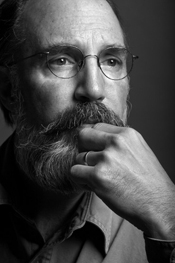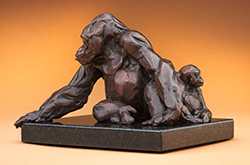BIOGRAPHY - Bart Walter (Born 1958)

The themes of art and nature were intertwined for Bart Walter very early in life. Born into a Baltimore family that encouraged a strong interest in the visual arts, he was also an enthusiastic participant in hunting and fishing trips to the eastern shore with his father. As a boy, he attended the local Friends School, and took a number of art classes at the Baltimore Museum of Art; he began carving in wood at age nine. By his teenage years, that interest in carving had evolved into a passion for sculpting images of the ducks that he studied during hunting and fishing expeditions. He carved his first bird in wood at age fourteen; his second carving of the same subject was his first sale. Walter comments that he “made enough from carving to have spending money during high school and college.” Equally important was his growing awareness that it might be possible to earn a living as a sculptor.
After high school Walter headed off to Hiram College, a historic liberal arts college in Ohio, to pursue a more marketable course of study in biology. The James H. Barrow Field Station, in particular, was home to a collection of waterfowl that captured his attention, thus allowing him to continue learning about the subject that he was sculpting--and selling--in his spare time. During his college years, Walter also met his future wife, Lynn, another biology student who shared his fascination with wildlife and animal behavior.
After graduation in 1980, Walter spent a year exploring career options while simultaneously waiting for Lynn to finish her schooling. The tension between pursuing an academic career in biology and being a sculptor presented a challenge, especially since Walter had already established a fledgling reputation for his bird carvings. In addition, the year-long break provided an opportunity to read extensively in art history and visit museums to study past masters directly, ultimately leading to the decision that sculpture was the direction he wanted to follow. Throughout the first half of the 1980s, Walter continued to focus on bird carvings in wood, and to build his portfolio.
All of that changed in 1986 when Lynn volunteered both Walter and herself as ushers for a lecture being given by the renowned anthropologist, Jane Goodall, at the College of William & Mary where Lynn was a graduate student in biology. During the reception following the lecture, Goodall admired the beautifully carved pin that Lynn was wearing, and that led to a discussion of Walter’s sculpture. By the end of the evening, Goodall had commissioned him to create a bronze sculpture of a chimpanzee. The next two years were filled with an in-depth study not only of chimpanzees, but also of bronze casting. By 1988, Walter had created two sculptures for Goodall’s review; she purchased both of them.
The year 1986 also included the Walter’s first trip to Africa, a “glorious time” when they first saw the “charismatic megafauna” such as elephants, lions, and giraffes.He recalls his astonishment that these animals were so readily accessible to a traveler, and notes that direct proximity to the animals convinced him that sculpting them on site was exactly what he wanted to do. Being on location would allow him to sculpt the animals in wax maquettes that would capture their daily activities. “Sculpting from life is easier than drawing from life because you can use whatever the animal presents to you. If it turns around, then you can turn the sculpture around too.” There is a precedent for this approach in the sculpture of Rembrandt Bugatti (1884-1916) who worked in front of live animals at both the Paris Jardin des Plantes and the Antwerp Zoological Gardens; working in the animals’ natural habitat, however, is a more immediate experience than observing them in a zoo.
Over the years, the Walters have returned often to central East Africa. Beginning in 1997, they traveled with their daughters, then seven and nine years old, routinely staying for two months in Kenya where they have developed a community of friends. Not surprisingly, Lynn Walter remarks that “it changed all our lives.” Bart has the daily support of his family, and the children have an incredible opportunity to live in--and learn from--an environment that is radically different from the US.
Walter traveled to Rwanda in 2004 to sculpt mountain gorillas, and in 2006, he traveled into Uganda to study chimpanzees in the wild. There, he spent a week following them through the forest, and observing their behavior as they searched for food during the day. In describing this experience, Walter comments that “their body language is similar to ours. The biologist in me enjoyed it; the artist in me was enraptured.” Since that first 1986 encounter with Jane Goodall, Walter has returned consistently to the study of chimpanzees, having now completed seventeen life-size bronze sculptures of them.
In recent years, Walter has also turned his attention to North American wildlife such as bison, moose and elk. Trips to the Rocky Mountains and northern Manitoba have produced bronzes of all these creatures as well as some sculptures of polar bears. The extreme cold of Manitoba, however, required a change in technique as Walter shifted from wax to epoxy in order to sculpt on site. Whether in Africa or North America, Walter’s fascination with sculpting animals remains constant: “I love being in wild places, and spending long periods of time with the animals. Sculpting from life over a prolonged time burns the image into my hands; it creates a whole body memory of the experience.” And sharing those experiences through his sculpture ultimately expands the viewers’ understanding of natural habitats that they are not likely to encounter directly.
Janet Whitmore, Ph.D.
Museums & Public Sites
Ruth Bancroft Garden, Walnut Creek, California
The Wildlife Experience, Parker, Colorado
The Great Ape Trust, Des Moines,Iowa
R. W. Norton Gallery, Shreveport, Louisiana
C. Burr Artz Library, Frederick, Maryland
Friends School of Baltimore, Baltimore, Maryland
The Maryland Zoo, Baltimore, Maryland
Northwest Middle School, Taneytown, Maryland
Salisbury University, Salisbury, Maryland
Waterfowl Festival Headquarters, Easton, Maryland
Westminster Library, Westminster, Maryland
Ella Sharp Museum of Art & History, Jackson, Michigan
Eastern Branch Library, Shrewsbury, New Jersey
Hiram Blauvelt Museum, Oradell, New Jersey
Monmouth Co. Public Library, Manalapan, New Jersey
North Carolina Zoological Park, Asheboro, North Carolina
Canton Museum of Art, Canton, Ohio
Brookgreen Gardens, Pawleys Island, South Carolina
The Hunter Museum of American Art, Chattanooga,Tennessee
Uganda Wildlife Authority, Kampala, Uganda
Jane Goodall Institute, Arlington, Virginia
The Worrell Collection, Charlottesville, Virginia
The Smithsonian National Zoo, Washington D.C.
Leigh Yawkey Woodson Art Museum, Wausau, Wisconsin
National Museum of Wildlife Art, Jackson, Wyoming

